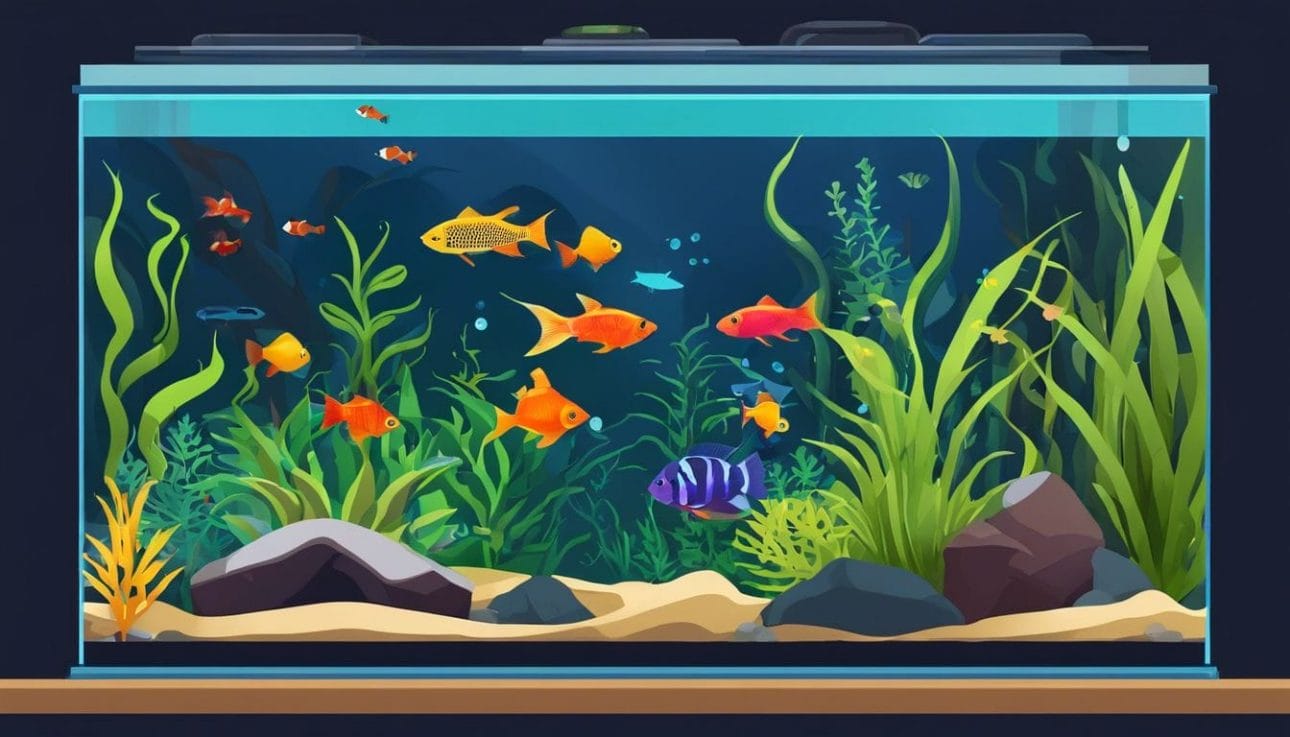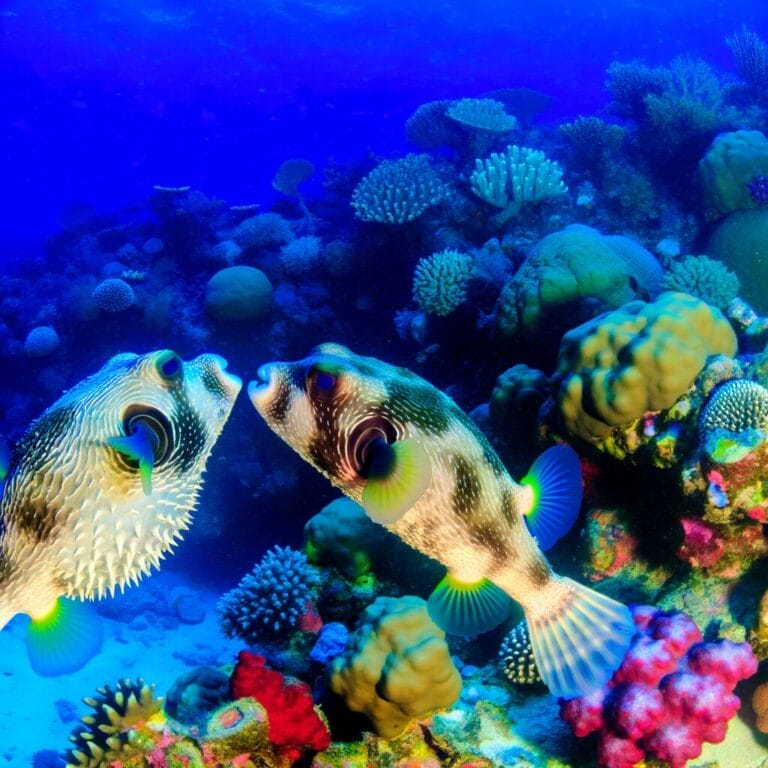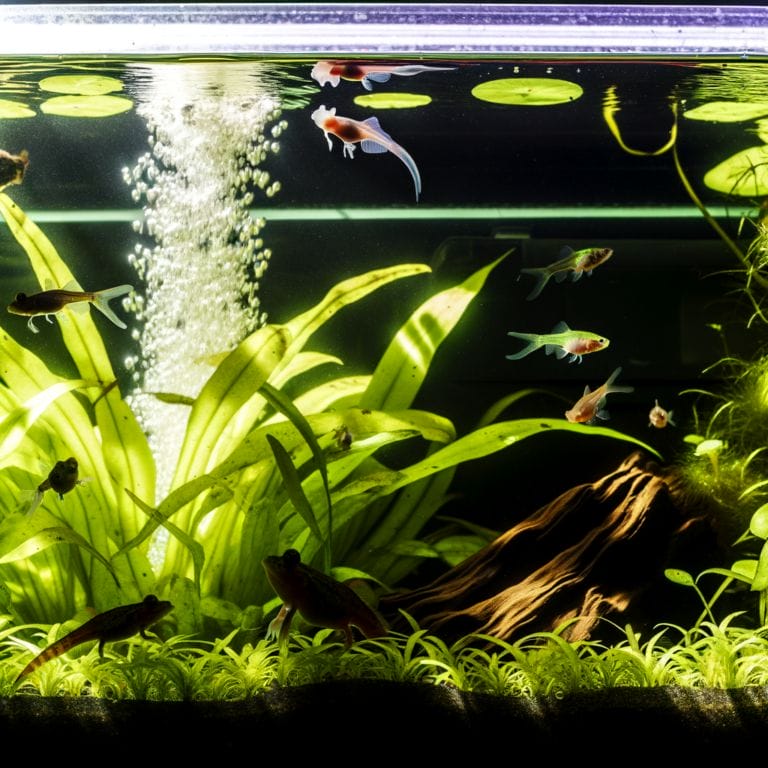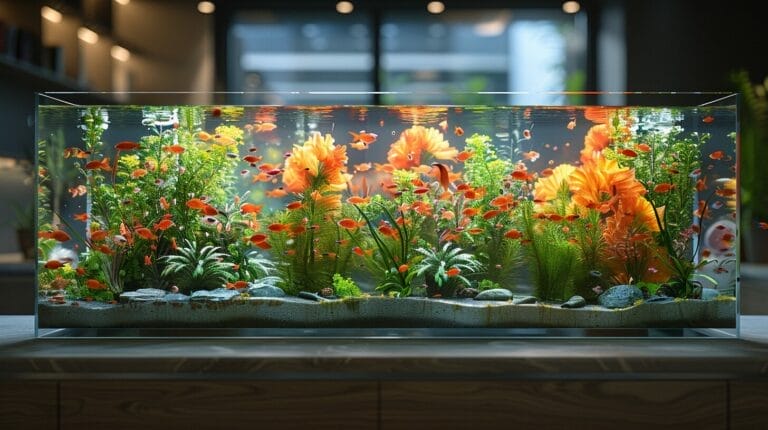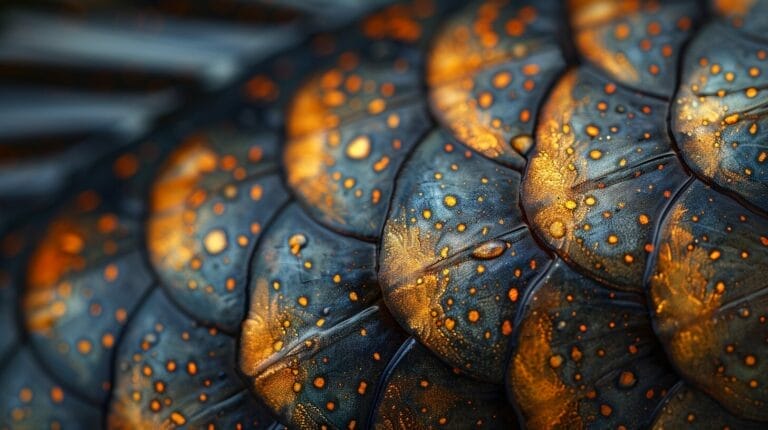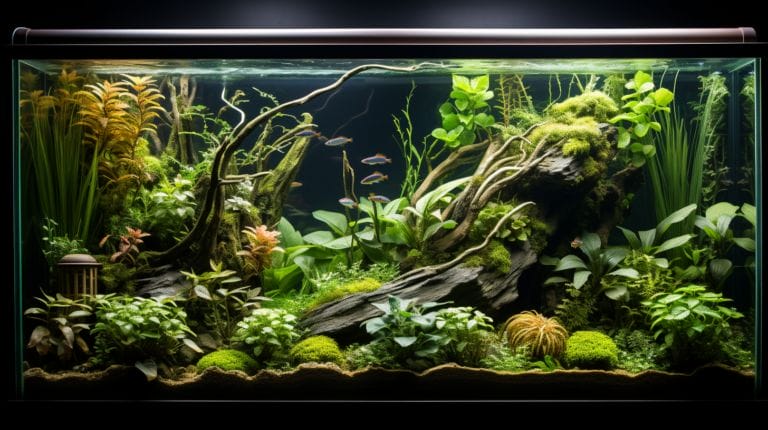DIY Guide: Homemade Filters for Fish Tanks – 10 Ideas to Try Today
Are you looking to optimize your fish tank’s ecosystem without breaking the bank? The secret may lie in a resourceful hobbyist’s approach: DIY aquarium filters. With an array of everyday items from the sanctuary of your own home, you can engineer an effective filtration system that rivals commercial counterparts.
As someone deeply immersed in marine aquariums, I’ve spent countless hours experimenting with and refining homemade solutions to ensure the healthiest environment for aquatic life.
Here’s a fact that might just tip the scales: certain DIY filter designs can offer customizable filtration options tailored precisely to your tank’s needs—something off-the-shelf models might not always provide.
From sponge marvels to bottle wonders, this article is teeming with ten inventive projects ready for you to dive into today. Ready for clearer waters ahead? Let’s make waves!
Key Takeaways
- You can make your own fish tank filters using common items like plastic bottles, Tupperware, and sponges.
- DIY filters help clean the water for your fish by removing waste and helping good bacteria grow.
- Homemade aquarium filters can be just as effective as store – bought ones and they can save you money.
- There are many different kinds of DIY filter projects, from simple sponge filters to complex multi-stage systems.
- Creating a filter yourself lets you customize it exactly for what your fish need.
Understanding How Aquarium Filters Work
Aquarium filters play a huge role in keeping your fish tank clean and your finned friends happy. Think of them as the water’s cleaning crew. They suck up the dirty water, trap all the yucky stuff like leftover food and waste, then push out clean water back into the tank.
This cycle keeps going to make sure the environment stays healthy for your fish.
There are different types of filters too. Some use sponges or pads that catch dirt when water flows through them. Others have special materials that help good bacteria grow; these bacteria break down harmful waste in the water.
There are even filters that do both jobs at once! Getting to know how each type works can help you choose the best one for your aquarium and keep your underwater world thriving.
Importance of Aquarium Filters
Now that you know how fish tank filters work, let’s talk about why they’re so important. Filters keep the water clean and safe for your fish. They take out bad stuff like waste, leftover food, and harmful chemicals.
This helps stop sickness in the tank. Clean water means happy and healthy fish.
A good filter makes a self-sustaining environment in your aquarium. It keeps everything balanced by helping good bacteria grow. These tiny helpers break down waste into less harmful substances.
For a thriving tank with clear water, getting the right filter is key!
Project 1: Sponge Filter
Dive into the world of DIY aquarium filtration with the humble yet effective sponge filter—a straightforward project that can significantly boost water clarity and health in your fish tank.
Ready to get your hands wet? Let’s start crafting!
Step-by-step guide to making a Sponge Filter
Sponge filters are a top choice for keeping your fish tank clean. They’re simple to make, and you can do it without spending much money.
- Gather your materials: A sponge, air pump, airline tubing, and a plastic tube or PVC pipe.
- Cut the sponge: Make a hole in the middle big enough for the plastic tube to fit snugly.
- Prepare the tube: If using PVC pipe, drill small holes along one side. This lets water flow through.
- Attach the tubing: Connect one end of the airline tubing to the air pump. Then attach the other end to the bottom of the plastic tube.
- Insert the tube into the sponge: Push it down so that it fits tightly in place.
- Position in tank: Put your new sponge filter on the bottom of your fish tank. Make sure it’s standing upright.
- Start pumping air: Turn on your air pump. Bubbles should rise from the tube, pulling water through the sponge.
- Check for flow: Watch to see if water is moving through. The sponge should start filtering out dirt from your tank.
Project 2: Capsule Filter
Imagine transforming everyday items into a functional and efficient part of your aquarium’s ecosystem—welcome to Project 2, the Capsule Filter. Here, I’ll walk you through crafting an ingenious filter from common materials that not only cleans your tank but also adds a touch of DIY ingenuity to your aquatic haven.
Step-by-step guide to making a Capsule Filter
You can make your own capsule filter for your fish tank. This kind of filter is good because it uses several steps to clean the water.
- Gather materials: You need storage tubs that are all the same size, clear tubing, glue, and a drill.
- Drill holes: Make many small holes in one of the storage tubs. Water will go through these holes.
- Connect tubing: Cut a piece of tubing. Attach one end to the drilled tub. Glue it so no water leaks out.
- Prepare filler: Choose things that help clean and kill germs in the water. Put these inside the drilled tub.
- Stack and secure: Place your drilled tub on top of another storage tub. Make sure they fit together well.
- Add water: Pour aquarium water into the top tub. It should flow through the filler, then come out clean in the bottom tub.
- Check for leaks: Look carefully at where you glued. If you see any drips, add more glue to seal them up.
Project 3: Bottle Filter
Dive into Project 3 and discover the eco-friendly ingenuity of transforming a simple plastic bottle into an effective aquarium filter. You’ll learn how to repurpose materials already at hand, crafting a unique filtration system that’s both cost-efficient and surprisingly simple to assemble—your fish will thank you for the clear water and healthy habitat!
Step-by-step guide to making a Bottle Filter
You love your fish and want to give them a clean home. A bottle filter can help make that happen. Here’s how you can build one yourself:
- Find a clean, empty water bottle and cut it in half.
- Choose a filter cartridge that fits well into the bottom half of the bottle.
- Get some aquarium – safe silicone and apply it to the edges of the filter cartridge.
- Place the cartridge inside the bottom half of the bottle. Make sure it’s secure.
- Take the top half of the bottle and flip it upside down. It should look like a funnel now.
- Cut a small hole in the cap of the water bottle. This is where water will flow through.
- Fit an air tube through that hole in the cap, ensuring it reaches below water level when assembled.
- Use more silicone to seal around where air tube meets cap to prevent leaks.
- Attach an air pump to the other end of this tube outside of your fish tank.
- Fill your new filter with chosen media like sponge, gravel or activated carbon to catch debris and purify water.
- Submerge your DIY filter into your aquarium, with the cap – end facing down towards gravel.
- Turn on your air pump and watch as dirty tank water gets pulled through homemade filter media.
Project 4: Dual Filter System
Discover the synergy of mechanical and biological filtration as we dive into Project 4, a Dual Filter System that’s not only efficient but remarkably simple to craft—get ready to elevate your fish tank’s clarity and health with this ingenious DIY project.
Step-by-step guide to creating a Dual Filter System
A dual filter system keeps your fish tank clean and healthy. It uses two tubs to double the filtration power.
- Get two storage tubs of the same size. These will hold your filter media.
- Drill holes in both tubs. Make sure they are big enough for the tubing but not too large.
- Cut a piece of tubing. This will connect the two tubs together.
- Use glue to secure one end of the tubing into the first tub. Wait until it’s fully dry and sealed.
- Repeat this process for the second tub, attaching the other end of the tubing.
- Fill both tubs with your chosen filter media. You can use things like sponge, ceramic rings, or bio – balls.
- Submerge these filled tubs in your aquarium or sump area. Arrange them so water can flow through each one easily.
- Connect an air pump or water pump to move water through your new dual filter system.
Project 5: Water Bottle Aquarium Filter
Transform that empty plastic bottle into a lifesaver for your finned friends with Project 5, where I’ll guide you through crafting a Water Bottle Aquarium Filter. This innovative DIY hack not only recycles but also keeps your aquatic ecosystem crystal clear—let’s dive in and get our hands wet!
Step-by-step guide to making a Water Bottle Aquarium Filter
You can keep your fish happy with a clean tank. Let’s make a water bottle aquarium filter with simple items.
- Find a plastic water bottle and cut the bottom off.
- Take off the cap and drill small holes in it. This helps water flow through.
- Grab some cotton balls, sponge, or filter floss. This catches dirt in the water.
- Layer sand, gravel, and activated charcoal inside the cut bottle. These help clean the water even more.
- Place your layers of cotton or sponge on top of the charcoal.
- Put the cap back on. Make sure it’s tight so nothing falls out.
- Attach a tube to the mouth of the bottle. You’ll use this to pull water through the filter.
- Get an air pump and connect it to the other end of your tube.
- Submerge your new filter in tank water with the cut end facing up.
- Turn on your air pump. Watch as your DIY filter starts cleaning.
Project 6: Multi-stage Aquarium Filter
For those of you with a passion for crystal-clear water and superior filtration, diving into Project 6 is a game-changer. Crafting your own Multi-stage Aquarium Filter offers an adventure in elevating water quality – fine-tune each stage to target specific debris and ensure peak aquatic conditions for your finned friends.
Step-by-step guide to creating a Multi-stage Aquarium Filter
Making your own multi-stage aquarium filter puts you in control of water quality. It’s a crafty project that keeps your fish happy and healthy.
- Gather all the necessary materials: same-size storage tubs, tubing, glue, and a drill.
- Drill holes in each tub for the water to pass through. These should be at the bottom of one side.
- Use glue to fix tubing into the holes. Make sure they are secure and waterproof.
- Stack the tubs so that water can flow from one to another via the tubes.
- In the first tub, place coarse mechanical media like sponges or foam pads. This will catch big waste particles.
- Add fine mechanical media to the next tub. Fine filter pads work well here.
- Include basic chemical media, like activated carbon, in another tub for removing impurities from the water.
- If needed, use specific chemical media like ammonia removers in yet another stage of your setup.
- The last tub should contain biological media such as bio – rings or ceramic noodles that host good bacteria.
- Set up a pump system to move water through your multi – stage filter. Begin with coarse mechanical and end with biological media.
Project 7: Tupperware Aquarium Filter
Discover just how versatile your kitchenware can be with Project 7, where I’ll show you how to transform a Tupperware container into an efficient aquarium filter – it’s simpler than you think and oh-so rewarding for your aquatic friends! Keep reading for the scoop on cleaner waters using items already at your fingertips.
Step-by-step guide to making a Tupperware Aquarium Filter
You want a clean tank for your fish without spending a lot? Try making your own Tupperware aquarium filter. It’s easy and cheap!
- Get a Tupperware container. Make sure it’s big enough to hold all the filter media you’ll need.
- Drill holes in the lid of the Tupperware. This is where water will flow in and out.
- Find a small pond or fountain pump that fits inside the Tupperware.
- Cut a piece of sponge to fit at the bottom of your Tupperware. This will be your first stage of filtration.
- Add ceramic rings or bio – balls over the sponge for biological filtration.
- Place activated carbon on top for chemical filtration, if needed.
- Attach tubing to your pump according to its instructions. Ensure one end goes into your tank, and the other connects to your Tupperware lid.
- Put everything together inside the Tupperware container carefully.
- Close the lid tight so nothing leaks out.
- Submerge the pump in your tank, plug it in, and watch it work!
Project 8: DIY Hanging Filters
Transform that empty corner of your aquarium into a powerhouse of filtration with DIY Hanging Filters. With everyday materials and a touch of creativity, you’ll learn to craft an overhead haven for beneficial bacteria, ensuring crystal-clear water for your aquatic friends.
Step-by-step guide to making DIY Hanging Filters
Hanging filters are great for your fish tank and don’t cost much to make. You can create a filter that hangs on the back of your aquarium with just a few materials.
- Gather Your Materials: You’ll need a small plastic container, such as a food storage box. Also, find some filter sponge or pad, tubing, a pump, and a drill.
- Drill Holes in the Container: Carefully drill many small holes in one side of your container. This side will face into the water.
- Cut Sponge to Fit: Take your sponge or filter pad and cut it so it fits snugly inside the container.
- Install Tubing and Pump: Connect tubing from the pump to an opening near the top of your container. Make sure it’s tight so water doesn’t leak.
- Place Filter Media Inside: Add ceramic rings or bio-balls on top of the sponge for extra filtration if you like.
- Attach to Your Tank: Hang the container on the back wall of your fish tank. Ensure it’s steady and won’t fall into the water.
- Start Your Pump: Plug in your pump. Water should move through the tubing into the container and flow out through all those little holes you drilled.
- Check Flow Rate: Adjust how fast water goes through if needed. It shouldn’t be too strong or too weak for your fish.
Project 9: Filter for Small Tanks
For those with petite aquatic havens, Project 9 is a godsend—learn how to assemble a compact filter that maintains pristine water conditions in smaller tanks. Dive into this project and ensure your finned friends enjoy clarity without the clutter of conventional filtration systems.
Step-by-step guide to making a Filter for Small Tanks
Keeping a small fish tank clean is key for your fishes’ health. You can make your own filter with simple materials and tools.
- Gather two same – size storage tubs, some tubing, strong glue, and a drill.
- Drill holes in one of the storage tubs to let water flow through.
- Cut the tubing to connect the two tubs; this will move water from one to another.
- Attach one end of the tubing firmly inside the first tub using glue.
- Set up the second tub with no holes above or beside the first tub.
- Place filter media—like sponge pieces or ceramic rings—in the second tub.
- Glue the other end of the tubing into this second tub so water gets cleaned passing through it.
- Make sure everything is dry and set before adding water.
- Fill both tubs with aquarium water; check for any leaks or spills.
- Use an air pump as power to move water through your homemade filter.
Project 10: No Electricity Aquarium Filter
Discover the innovation behind creating a No Electricity Aquarium Filter, a sustainable solution for your aquatic friends that doesn’t rely on power – perfect for off-grid setups or energy-saving goals; dive into the details and see just how accessible and efficient this eco-friendly option can be.
Want to learn more? Keep reading to find out how you can make one today!
Step-by-step guide to making a No Electricity Aquarium Filter
You want to keep your fish happy and healthy, but what if you’re not near a power source? No worries! You can make a no electricity aquarium filter with just a few items. Here’s how:
- Get a clean plastic bottle.
- Cut off the bottom of the bottle.
- Turn the bottle upside down – the cap should be at the bottom now.
- Poke small holes in the bottle cap with a needle or small nail.
- Slide an air stone inside, all the way to the cap.
- Attach an air tube to the air stone sticking out of the neck.
- Fill the bottle with filter media like sponge or ceramic rings around the air stone.
- Hang or place this in your tank so water can flow through it easily.
Conclusion
Building your own fish tank filter is not only fun but super useful. You now have 10 cool ideas to keep your aquarium clean and your fish happy. These projects use simple items from around the house, and they save you money too! Remember, a good filter makes sure your water stays clear and healthy for your underwater friends.
So give one of these DIY filters a try – it’s easier than you think, and the results are amazing for your fish!
FAQs
[Article 2 Keywords]:
DIY homemade fish tank filters
creative filter solutions
aquarium maintenance
cost-effective alternatives
natural filtration methods
activated carbon
sponge filters
biological filtration
recycled materials
mechanical filtration
1. Can I make my own fish tank filter at home?
Yes, you can build a DIY homemade fish tank filter using cost-effective alternatives and natural filtration methods. It’s a smart way to keep your aquarium clean.
2. Are there creative filter solutions that use recycled materials?
Definitely! Creative filter solutions often include using recycled materials like plastic bottles for mechanical filtration or old sponges for biological growth.
3. How does activated carbon work in homemade filters?
Activated carbon works like a magnet in your DIY filter—it grabs onto the bad stuff from the water, making it cleaner for your fish.
4. What are sponge filters and why should I use them in my aquarium?
Sponge filters are simple yet effective; they trap debris and support good bacteria that help break down waste in the water—perfect for keeping your aquarium healthy on a budget!


